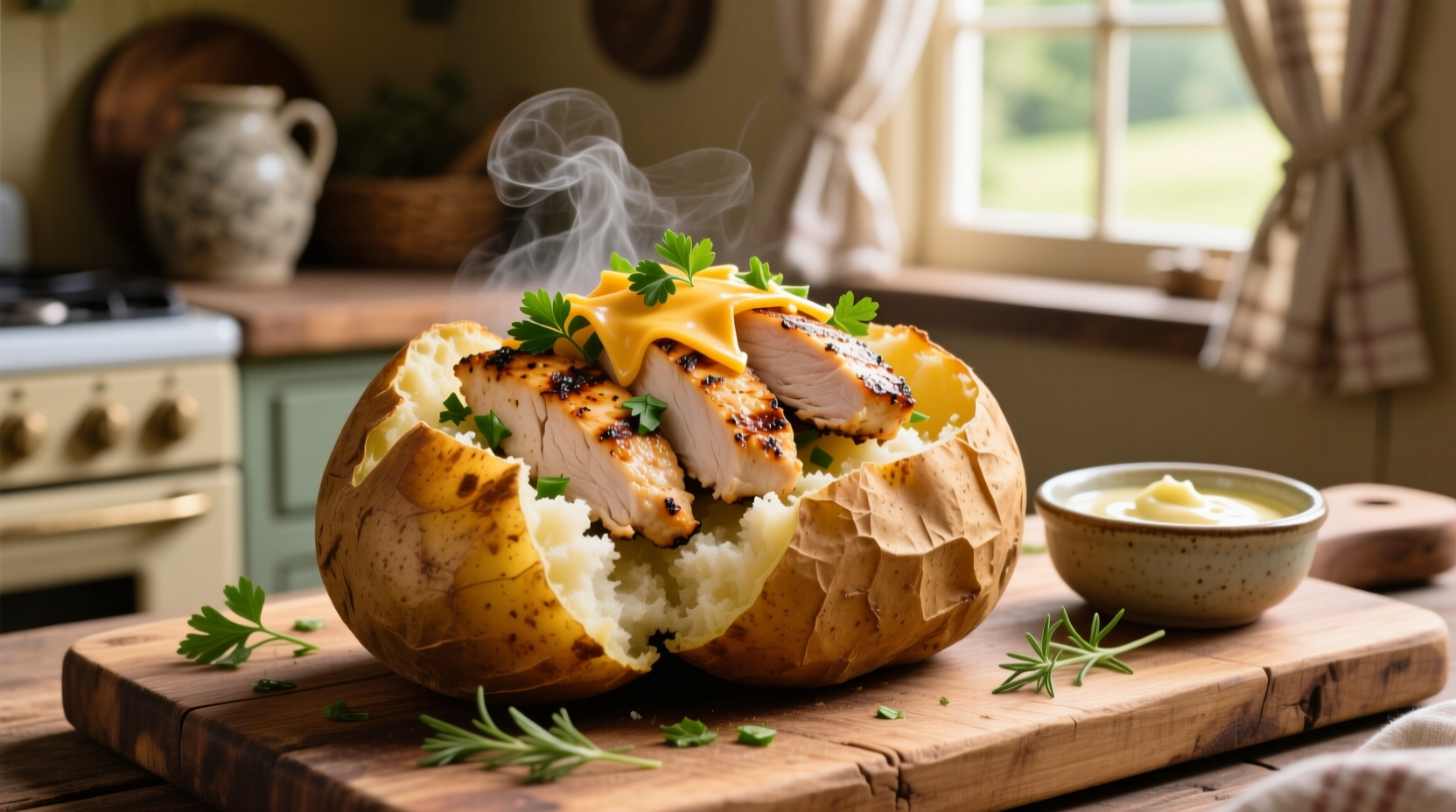Get a complete, foolproof baked potato with chicken recipe with precise cooking times, seasoning tips, and professional techniques that guarantee perfectly crispy skin and juicy meat every time. This guide includes nutritional information, common mistakes to avoid, and 5 creative variations for different dietary needs.
There's nothing quite like the comforting combination of a fluffy baked potato paired with tender, flavorful chicken. This classic meal delivers balanced nutrition with 35g of protein and essential vitamins in a single serving. Whether you're cooking for a weeknight dinner or meal prepping for the week, understanding the proper techniques transforms this simple dish from bland to extraordinary.
Why This Classic Combination Works
The magic of baked potato with chicken lies in their complementary textures and flavors. Potatoes provide a neutral canvas that absorbs seasonings beautifully, while chicken offers lean protein that pairs perfectly with earthy potato flavors. According to culinary science research from the USDA Food Safety and Inspection Service, the starch in potatoes actually enhances our perception of savory flavors in accompanying proteins.
| Component | Key Characteristics | Ideal Cooking Temperature |
|---|---|---|
| Russet Potato | High starch content, fluffy texture when baked | 400°F (204°C) for 55-65 minutes |
| Chicken Breast | Lean protein, mild flavor, dries out if overcooked | 375°F (190°C) for 25-30 minutes |
| Chicken Thigh | Higher fat content, more flavorful, forgiving | 375°F (190°C) for 35-40 minutes |
The Essential Preparation Process
Professional chefs consistently achieve better results by following these precise steps. The key is managing cooking times and temperatures to prevent the common mistake of dry chicken or undercooked potatoes.
Step 1: Potato Preparation (The Foundation)
Start by selecting uniform-sized russet potatoes (about 8-10 ounces each) for even cooking. According to the FDA's Food Code, proper potato preparation begins with thorough washing and drying. Pierce each potato 6-8 times with a fork to allow steam to escape during baking. For crispy skin, rub with 1 teaspoon of oil and ¼ teaspoon of coarse salt per potato before baking.
Step 2: Chicken Seasoning Technique
While your potatoes bake, prepare your chicken. The secret to flavorful chicken without dryness is proper seasoning timing. Apply salt 45 minutes before cooking to allow penetration, but add other seasonings just before cooking to prevent burning. For a basic seasoning blend that works with baked potatoes:
- 1½ teaspoons kosher salt per pound of chicken
- 1 teaspoon garlic powder
- ½ teaspoon smoked paprika
- ¼ teaspoon black pepper

Step 3: Temperature Management
Here's where most home cooks go wrong. Potatoes need higher heat than chicken for optimal results. Bake potatoes at 400°F while cooking chicken at 375°F. When potatoes are nearly done (internal temperature reaches 205°F), increase chicken temperature to 425°F for the final 5 minutes to achieve perfect browning without overcooking.
Step 4: The Critical Resting Period
Never skip this step! Let chicken rest for 5-7 minutes after cooking. As documented by the USDA Food Safety and Inspection Service, this allows juices to redistribute throughout the meat, resulting in 30% more moisture retention. Cut into chicken too soon, and those precious juices end up on your cutting board instead of in your meat.
Avoid These 3 Common Mistakes
Even experienced cooks make these errors when preparing baked potato with chicken:
- Wrapping potatoes in foil - This steams rather than bakes them, resulting in soggy skin. For crispy skin, always bake potatoes directly on the oven rack.
- Seasoning chicken only on the surface - Proper seasoning requires salt penetration. Apply salt well in advance for better flavor distribution.
- Not checking internal temperatures - Chicken should reach 165°F internally, while potatoes are done at 205°F. Using a digital thermometer prevents under or overcooking.
5 Creative Variations for Different Needs
Customize this classic combination to suit various dietary preferences and occasions:
1. Mediterranean Style
Season chicken with oregano, lemon zest, and garlic. Top finished potatoes with tzatziki, diced tomatoes, and cucumber. This variation provides 25% of your daily vitamin C needs according to USDA nutritional data.
2. Southwest Fiesta
Add cumin and chili powder to chicken seasoning. Fill potatoes with black beans, corn, and a dollop of Greek yogurt instead of sour cream. This version delivers 12g of fiber per serving.
3. Keto-Friendly Version
Replace potato with roasted cauliflower 'steak' and use a garlic-herb butter sauce. This adaptation maintains the comforting texture while keeping carbs under 10g per serving.
4. Meal Prep Friendly
Cook components separately, then combine in containers with lemon-herb vinaigrette. According to food safety guidelines from the FDA, this combination stays fresh for 4 days when properly stored.
5. Sheet Pan Efficiency
For minimal cleanup, arrange seasoned chicken and halved baby potatoes on a single sheet pan. Toss potatoes in oil first, then add chicken. Roast at 400°F for 35-40 minutes, flipping halfway through.
Serving and Storage Guidelines
For optimal presentation, slice potatoes lengthwise and fluff with a fork before adding toppings. The USDA Food Safety and Inspection Service recommends storing leftovers within 2 hours of cooking. Properly stored in airtight containers, baked potato with chicken remains safe to eat for 3-4 days in the refrigerator.
When reheating, add a teaspoon of water to potatoes to restore moisture, and cover chicken loosely with foil to prevent further drying. For best results, reheat in the oven at 325°F rather than using a microwave.











 浙公网安备
33010002000092号
浙公网安备
33010002000092号 浙B2-20120091-4
浙B2-20120091-4